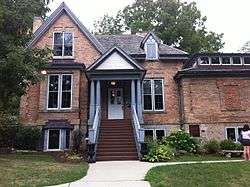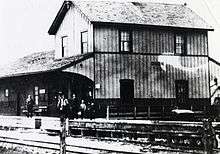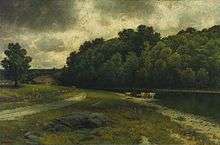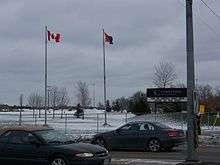Doon, Ontario
Doon is a former village in southwestern Ontario, Canada. Doon was settled around 1800 by Mennonite Germans from Pennsylvania, and after 1830 by Scottish immigrants. The area is located at the confluence of Schneider Creek and the Grand River. The post office was opened in 1845. A large flour mill, oatmill mill, distillery and sawmill were built on the Doon River over the following years. The Perine brothers established extensive linen works and flax mills near the settlement. By 1870, there was a single church, Presbyterian, a variety of tradesmen and a population of 200.[1]
Doon, Ontario | |
|---|---|
 Homer Watson House / Doon School of Fine Arts | |
 Doon, Ontario | |
| Coordinates: 43.392173°N 80.414304°W | |
| Country | Canada |
| Province | Ontario |
Although never large, at one time it was a bustling community with sawmills, a rope factory and other businesses.
It is known as the lifetime home of landscape artist Homer Watson. It is now a suburb of Kitchener, Ontario, home to the Doon Heritage Village and the main campus of Conestoga College.
Origins
Doon was established in a forested area around Schneider Creek where it enters the Grand River from the south. Richard Beasley sold 3,600 acres (1,500 ha) of this land to John Biehn Sr. of Montgomery County, Pennsylvania, in 1800. Biehn's relatives bought portions of this land, and started to clear it for farming, His son John Biehn Jr. built a sawmill in what became Doon, and Frederic Beck also ran a sawmill in the area. Most of the early settlers were German Mennonite farmers from Pennsylvania.[2]
By 1869, the population was 200 and the settlement had a station on the Grand Trunk Railway.[3]
Growth
In the 1830s the Ferrie family moved to the area, where they established several businesses in what is now Lower Doon including a distillery, tavern, general store, saw mill, cooperage, blacksmith shop and kiln. They also built workers' houses. Adam Ferrie Jr. gave Doon its name after Loch Doon and the River Doon in Ayrshire, Scotland. From this time most of the settlers were artisans, millers and brick makers of Scottish and English background. Doon Mills, driven by water, was fully operational in 1839, grinding oatmeal, flour, and barley for the local population. The population of Doon in 1855 was 200.[2]
The hamlets to the west, about a mile further up Schneider Creek, were originally called Oregon and Tow Town. They later merged and were called Upper Doon. James Watson, grandfather of the painter Homer Watson, set up a sawmill, carding and fulling mill and a pail factory in Oregon. John Tilt had a small sawmill and an enterprise for clay brick and tile manufacture, also in Oregon.
In Tow Town, Moses and Joseph Perine established a sawmill and a flax mill that made rope and twine, the first in Canada of this nature.[2] The Doon Twine and Cordage factory opened in 1856 making products from locally-grown flax and hemp. Products included tying twines, plow lines, halter ropes, clothes lines and broom twine. Farmers were later banned from growing hemp because of its cannabis content. There was also a decline in local production of flax, so the factory had to import both of these raw materials.[4]

A railroad station opened around 1867.[2] It was on the Galt-Elmira branch of the Grand Trunk Railway.[5] A daily service called the Dutch Mail took freight and passengers between Doon and Berlin (later renamed Kitchener).[2] New businesses served the growing population. By the early 1890s there was a post office, grocer and baker, two tailors, a cooper, blacksmith, shoemaker, wagon maker, bridge builder and scissors manufacturer.[2] By the end of the 19th century visitors could stay in the Red Lion Inn, Doon Hotel or the Bush Inn, all respectable establishments.[2]
A non-denominational Sunday School was founded in 1848. In 1854 the Doon Presbyterian Church was opened on land donated by Robert Ferrie and built with his financial assistance. A Methodist church was built in 1868 on a site donated by William Allen.[2] The Bonnie Doon School was the first public school, opened in 1878 with one room, and extended to two rooms within ten years as the student population grew. The school burned down and was replaced in 1956.[2] The Christadelphians built a church on Old Mill Road, formerly Richmond Street, in 1880. In 1889 it was clad in red brick. The church was used until 1916. The building was closed until 1936, then used as a residence until 1971. It was torn down in 1981.[6]
Notable residents

Moses Springer (1824–1898) was born in Doon on 31 August 1824. In 1834 he and his ten siblings were orphaned when their parents died in a cholera epidemic. He was raised in Hespeler by the Mennonite Bishop Joseph Hagey and became a teacher and later a businessman in Waterloo. He was reeve of the village of Waterloo three times between 1857 and 1875, and represented the North Waterloo riding in the Ontario Legislature from 1867 to 1881.[7]
Homer Watson (1855–1936) was a self-taught painter who devoted most of his life to painting landscapes of the country of Doon in a combination of romantic and realistic styles.[8] Oscar Wilde called Watson "the Canadian Constable". A field stone house, built in 1835, that lies south of the village was Watson's house from 1881 until his death in 1936.[9] Homer's sister Phoebe Amelia Watson moved into Homer's house after his wife Roxanna died in 1918.[10] She became curator of the Homer Watson Art Gallery in Doon, and held this post until her death on 22 October 1947.[11]
Hartman Krug (1853–1933) was born in New Dundee and followed his father's profession as a fine furniture maker. He moved to Berlin and founded the H. Krug Furniture Company in the 1887.[12] In 1912 Krug became the majority shareholder in Doon Twine and Cordage Company, which was renamed Doon Twines Ltd. The company began manufacturing cordage with jute, manila, hemp and sisal. To accommodate growth and reduce transportation costs, in 1916 the operation was moved from Doon to a larger factory in Kitchener.[4]
Beniah Bowman (1886–1941) was born in Waterloo county into a United Empire Loyalist family. He was educated in the Doon and Hespeler public schools. In 1911 he became a farmer on Manitoulin Island. Bowman was a member of the Ontario Legislature from 1918 to 1926, and was Ontario Minister of Lands and Forests from 1919 to 1923.[13]
Hilda Ranscombe (1913–1998) was born in Doon, and became a star ice hockey player on the Preston Rivulettes.[14]
Recent years

The population of Doon dropped sharply after the Doon Twines company relocated to Berlin, now Kitchener, during World War I.[2][lower-alpha 1] There are now only a few small businesses in Doon, which has become a suburb for commuters to Kitchener and Cambridge.[2]
After Phoebe Watson died the Watson house was home to the Doon School of Fine Arts from 1948 to 1966.[16] The house, a substantial building in Scottish Gothic Vertical style that was built in 1834 by Adam Ferrie, was purchased by the City of Kitchener in 1981 and opened to the public as a historic building and art gallery.[17] The Homer Watson Memorial Park lies next to the village.[9]
Doon contains the Doon Heritage Village, which covers 60 acres (24 ha) and reconstructs a view of life in the region in 1914, on the eve of World War I. There are period buildings, farm animals and interpreters dressed in period clothes. The Waterloo Region Museum is at the entrance to the village.[18] The former house of Peter McArthur was transported to the village from its original location on land owned by the McArthur family near Appin, Ontario in Ekfrid Township.[19] Hugh C. Elliott (1899-1995), who had served in 1918–19 with the Canadian Engineers in Vladivostok, Siberia, was a charter director of the Doon Pioneer Village.[20]
Conestoga College Institute of Technology and Advanced Learning is a polytechnic established in 1967.[21] The original campus of Conestoga College, and the largest, is located in Doon by the Highway 401 / Homer Watson Blvd. interchange. The campus holds the college's main administrative offices. There are residences for full-time students next to the campus. A 3-storey 75,000 square feet (7,000 m2) wing for the School of Health and Life Sciences opened in August 2011.[22]
References
Notes
- Many of the newcomers to the region were of German origin, often Mennonite. The area was named Berlin in 1833, and the village of Berlin was made the county seat of the county of Waterloo in 1856. During World War I, due to anti-German feelings, the city was renamed Kitchener, after the British general Herbert Kitchener, 1st Earl Kitchener.[15]
Citations
- http://www.collectionscanada.gc.ca/obj/001075/f2/e010780571_p2.pdf
- Doon, Waterloo Township, WRM.
- https://books.google.ca/books?id=z6wOAAAAYAAJ, page 132
- Doon Twines, Western Libraries.
- Doon, Ontario railway station, KPL.
- Christadelphian Church, Doon, Ontario, KPL.
- Early Mayors – Moses Springer.
- Homer Watson, National Gallery.
- Colombo 1984, p. 118.
- Homer Watson House & Gallery.
- Phoebe Amelia Watson, WatGen.
- Hartman Krug, Kitchener Public Library.
- Beniah Bowman Dies ... 1941, p. 28.
- "Hilda Doris Ranscombe". Waterloo Region Generations. Retrieved 2018-12-16.
- About Kitchener, City.
- History - Doon School of Fine Arts.
- History, Homer Watson House and Gallery.
- Doon Heritage Village, Waterloo Region Museum.
- Colombo 1984, p. 117.
- Sapper Hugh C. Elliott.
- College Profile / Stats, Conestoga.
- Doon (Kitchener) Campus, Conestoga.
| Wikimedia Commons has media related to Doon, Ontario. |
Sources
- "About Kitchener". City of Ktchener. Archived from the original on 2017-02-06. Retrieved 2014-07-17.
- "Beniah Bowman Dies in Toronto on Easter - Had been Ill for some time". Through the Years. VIII (11). September 1941. Retrieved 2014-07-16.
- "Christadelphian Church, Doon, Ontario". Kitchener Public Library. Retrieved 2014-07-15.
- "College Profile / Stats". Conestoga College. Retrieved 2014-07-16.
- Colombo, John Robert (1984-01-01). Canadian Literary Landmarks. Dundurn. ISBN 978-1-4597-1798-5. Retrieved 2014-07-15.CS1 maint: ref=harv (link)
- "Doon Heritage Village". Waterloo Region Museum. Archived from the original on 2010-11-24. Retrieved 2014-07-16.
- "Doon, Ontario railway station and freight shed". Kitchener Public Library. Retrieved 2014-07-15.
- "Doon (Kitchener) Campus". Conestoga College. Retrieved 2014-07-16.
- "Doon Twines, Limited". Western Libraries. Western University. Archived from the original on 2014-07-25. Retrieved 2014-07-16.
- "Doon, Waterloo Township". Waterloo Region Museum. Archived from the original on 2011-08-18. Retrieved 2014-07-15.
- "Early Mayors – Moses Springer, 1824-1898" (PDF). City of Waterloo. Archived from the original (PDF) on 2013-06-18. Retrieved 2014-07-16.
- "Hartman Krug". Kitchener Public Library. Retrieved 2014-07-16.
- "History - Doon School of Fine Arts". Homer Watson House. Archived from the original on 2014-08-08. Retrieved 2014-07-16.
- "History, Homer Watson House and Gallery". Homer Watson House. Archived from the original on 2014-08-08. Retrieved 2014-07-16.
- "Homer Watson". National Gallery of Canada. Retrieved 2014-07-15.
- "Homer Watson 1855 – 1936". Homer Watson House & Gallery. Archived from the original on 2014-07-29. Retrieved 2014-07-15.
- "Phoebe Amelia Watson". Waterloo Region Generations. 2014. Retrieved 2014-07-15.
- "Sapper Hugh C. Elliott, Royal Canadian Engineers". Kitchener Public Library. Retrieved 2014-07-16.